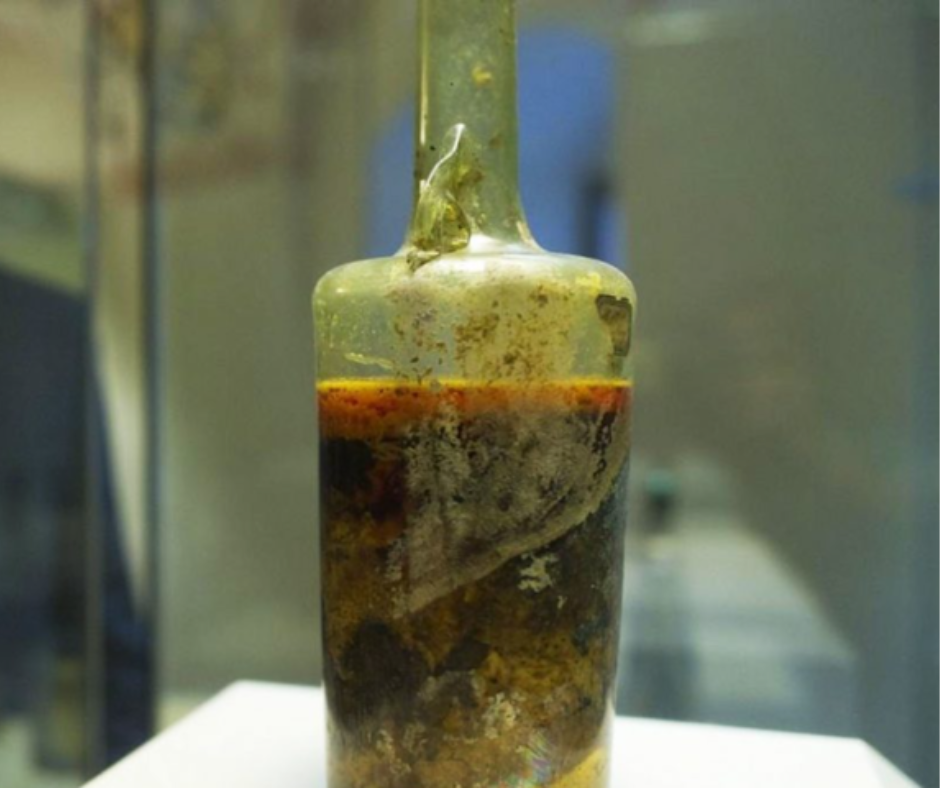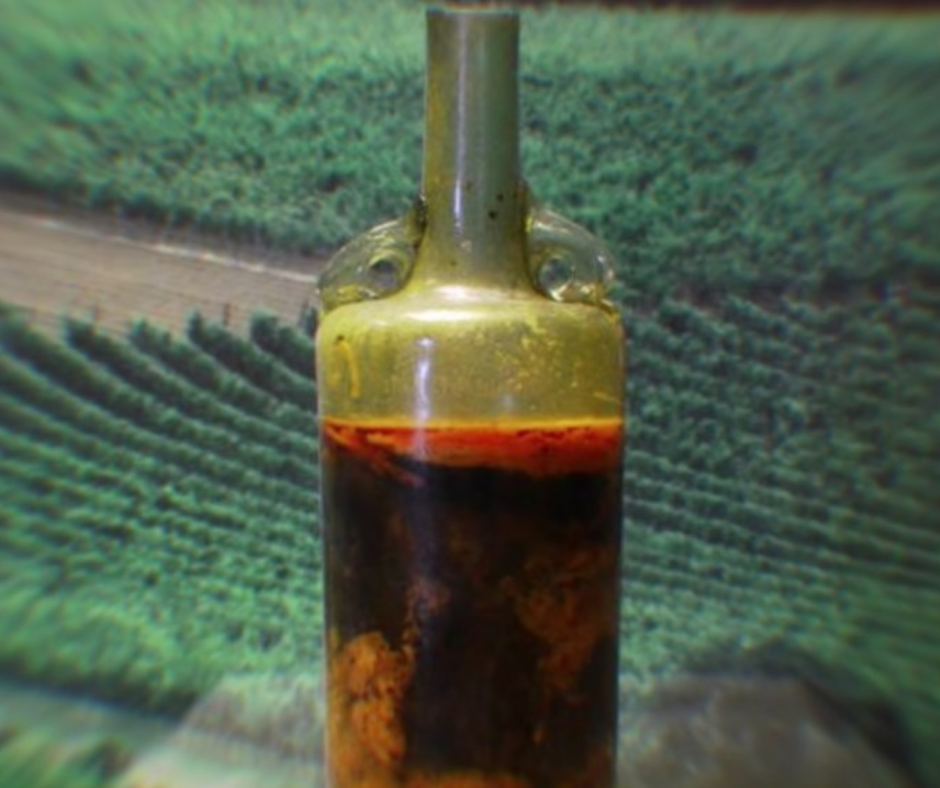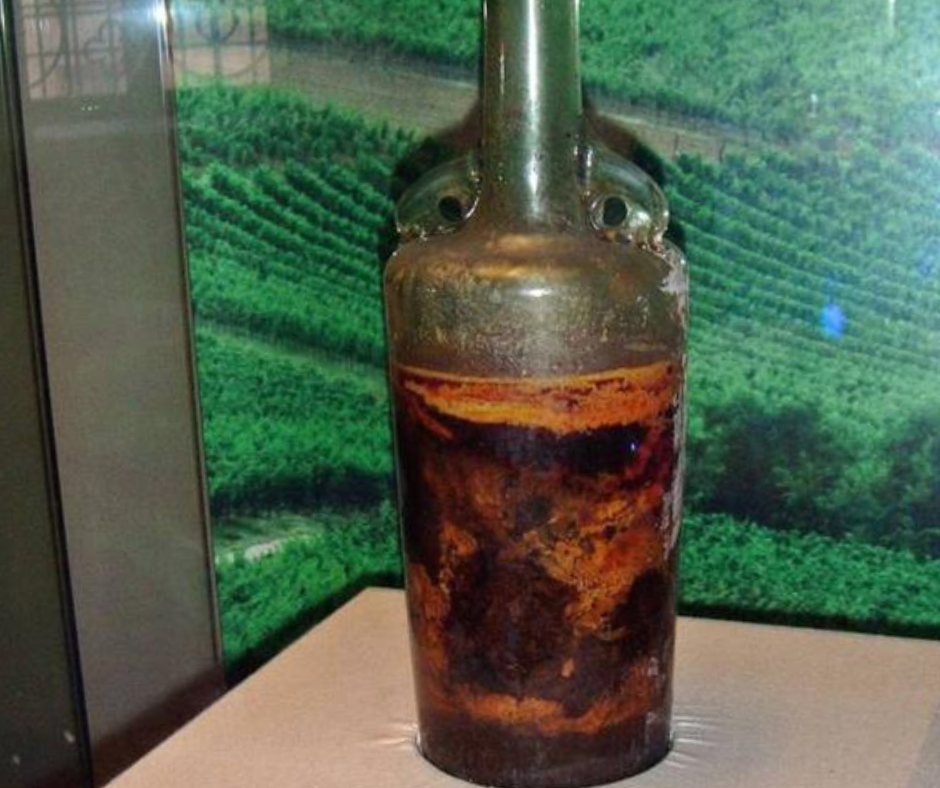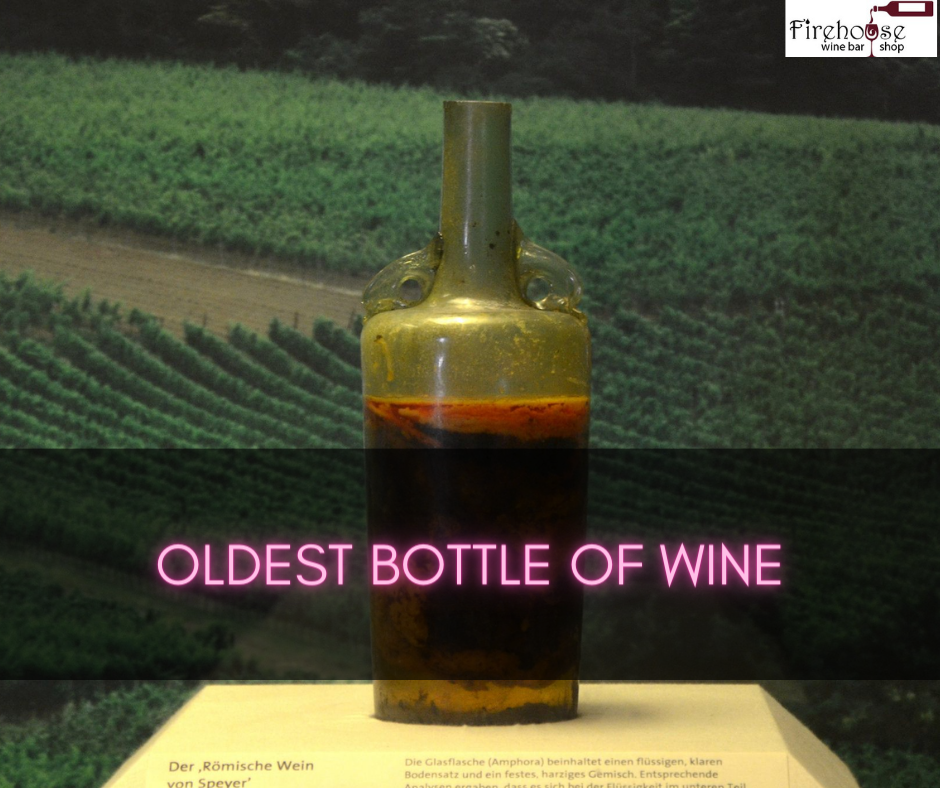Introduction
Overview Of The Oldest Bottle Of Wine And Its Significance
The oldest bottle of wine in the world, the Speyer wine bottle, is a remarkable artifact that has captivated historians, archaeologists, and wine enthusiasts alike. Discovered in 1867 near Speyer, Germany, this bottle is estimated to date back to 325 and 350 AD, making it more than 1,600 years old. This bottle is even more intriguing because it remains unopened, preserving its contents throughout the centuries.
The significance of this ancient wine bottle lies not only in its age but also in the insight it provides into the history of winemaking. By studying the preservation techniques used during the ancient Roman era, researchers can gain valuable knowledge about how wines were produced, stored, and enjoyed in antiquity. This unparalleled glimpse into the past allows us to unravel the secrets of ancient winemaking practices and appreciate the rich cultural heritage associated with this timeless beverage.
Historical Background Of Ancient Wines
The ancient Romans were renowned for their mastery of winemaking and their appreciation for the pleasures of drinking wine. Wine was integral to their culture, spreading vineyards across their vast empire. The Romans developed advanced techniques for grape cultivation, harvesting, and wine production, which laid the foundation for modern winemaking practices.
During ancient times, wine was considered a beverage with significant social, religious, and medicinal importance. It was considered a symbol of wealth and sophistication, often reserved for special occasions and lavish feasts. The Romans believed in the medicinal properties of wine and used it as a remedy for various ailments.
The discovery of the Speyer wine bottle further reinforces the longstanding human connection to wine, showcasing how this cherished beverage has transcended borders and stood the test of time. It serves as a reminder of the ancient traditions and cultural legacies that have shaped our modern society.
In conclusion, the oldest bottle of wine holds a special place in history, allowing us to delve into the past and better understand our ancestors’ customs and practices. Its significance extends beyond its age, revealing the fascinating world of ancient winemaking and the enduring allure of this timeless elixir.

The Discovery
Unearthing The Oldest Bottle Of Wine
The Speyer wine bottle, known as the oldest bottle of wine in the world, is a remarkable archaeological find that offers a unique glimpse into ancient winemaking practices. Discovered in 1867 near Speyer, Germany, this ancient artifact has captured the curiosity of historians and wine enthusiasts alike.
The bottle, estimated to be between 1,650 and 1,700 years old, was found intact and unopened, its contents having been preserved over the centuries. Its unbroken seal and intact cork have allowed experts to study the wine preserved inside, providing valuable insights into the techniques used for winemaking during the Roman era.
Description And Location Of The Discovery
The Speyer wine bottle was originally found in what is now the German region near Speyer, one of the oldest settlements in the area. This location holds significant historical significance, as it was part of the ancient Roman Empire. The area was known for its vineyards, demonstrating the importance of winemaking in the region.
The bottle is made of greenish-yellow glass and stands about 7.5 inches tall. It features a narrow neck and a rounded body, typical of the Roman glassware of that period. The bottle’s design reflects the craftsmanship of the time, showcasing the skilled glassblowing techniques employed by ancient artisans.
With an estimated age of over 1,600 years, the Speyer wine bottle remains a testament to the enduring legacy of wine. Its discovery offers a window into ancient winemaking practices and highlights the cultural significance of wine in the Roman Empire. The well-preserved state of the bottle allows researchers to study its contents, unveiling secrets about the flavors, fermentation methods, and storage techniques of wines from that era.
In conclusion, discovering the oldest bottle of wine near Speyer, Germany is a significant archaeological find. It provides a tangible link to the past, unraveling the age-old winemaking practices in ancient times. Preserving the bottle and its contents sheds light on wine’s historical and cultural importance, reaffirming its timeless allure in human civilization.
Unraveling The Age
Methods Used To Determine The Age Of The Wine
When it comes to unraveling the age of the oldest bottle of wine in the world, scientists and historians employ various methods to piece together its history. One such method is carbon dating analysis, which uses the decay of carbon-14 isotopes to determine the age of organic materials, including wine.
Carbon dating analysis involves measuring the levels of carbon-14 isotopes in the wine. The amount of carbon-14 in the atmosphere has varied over time due to changes in solar radiation and human activities. By comparing the levels of carbon-14 in the wine with known atmospheric samples from different periods, experts can estimate the vintage of the wine within a certain range.
Another method that can be utilized is studying the bottle itself. Experts examine the bottle’s craftsmanship, shape, and design to determine its era. The techniques used in glassblowing during different periods can provide valuable clues about the bottle’s age and, by extension, the wine inside.
Carbon Dating Analysis And Its Limitations
While carbon dating analysis is a valuable tool for determining wine’s age, it has limitations. One limitation is that the accuracy of carbon dating decreases as the age of the wine increases. Over time, the carbon-14 isotopes in the wine may have decayed to such low levels that they become difficult to measure accurately.
Another limitation is the possibility of contamination. The wine might have been exposed to different carbon sources throughout its history, which can skew the results of carbon dating analysis. Additionally, carbon dating accuracy depends on the availability of atmospheric samples from the same period as the wine.
Despite these limitations, carbon dating analysis remains a valuable tool for researchers to unravel the age of the oldest bottle of wine. By combining this analysis with the bottle study, experts can paint a clearer picture of the wine’s origins and the winemaking practices of ancient times.
The discovery of the oldest bottle of wine near Speyer, Germany, is a remarkable archaeological find. Researchers can uncover the secrets of ancient winemaking practices by employing methods such as carbon dating analysis and studying the bottle’s design. This knowledge adds to our understanding of history and highlights wine’s enduring allure and cultural significance throughout the centuries.

Ancient Winemaking Techniques
Insight Into The Winemaking Practices Of The Time
The discovery of the oldest bottle of wine near Speyer, Germany, has provided valuable insight into the winemaking practices of ancient times. Scientists and historians have analyzed the bottle and its contents to unravel the age and understand the techniques used during that era.
The ancient winemakers utilized a variety of methods to produce their wine. One of the key techniques involved using clay pots for fermentation and storage. These pots were designed to maintain the ideal temperature and humidity for fermentation. The porous nature of the clay allowed for a slow and controlled fermentation, resulting in a well-balanced and flavorful wine.
Interestingly, the ancient winemakers also understood the importance of pressing the grapes to extract the juice. Evidence of wine presses found in archaeological sites, such as the Armenian cave, indicates that the early winemakers employed advanced techniques to extract the juice efficiently. This process involved crushing the grapes using stone or wooden tools and then placing the mixture into storage vessels for fermentation.
Role Of Clay Pots And Fermentation Processes
Using clay pots was integral to the winemaking process in ancient times. These pots provided the ideal environment for fermentation and helped impart unique flavors and characteristics to the wine. The porous nature of the clay allowed for a gentle exchange of oxygen, which influenced the aging process and added complexity to the wine.
Furthermore, the fermentation process played a crucial role in developing the wine. The ancient winemakers understood that the transformation of grape juice into wine required the action of yeast. They relied on the natural yeasts on the grape skins and in the environment to initiate fermentation. This natural fermentation contributed to the unique flavors and aromas of ancient wines.
Overall, the ancient winemaking techniques discovered through the study of the oldest bottle of wine offer a fascinating glimpse into the sophistication of early winemaking. The careful selection of grapes, the use of clay pots for fermentation, and the reliance on natural yeasts all contribute to the rich history and legacy of winemaking. These techniques have provided a foundation for the evolution of winemaking, shaping the practices and traditions we still admire today.
Preservation And Aging
Factors That Contribute To The Preservation Of Ancient Wines
The discovery of the oldest bottle of wine near Speyer, Germany, has provided insights into ancient winemaking techniques and raised questions about how wine can be preserved over such a long period. Several factors have contributed to the preservation of these ancient wines.
One of the key factors is the composition of the wine itself. Ancient winemakers were known to produce wines with high tannin and acidity content. These components act as natural preservatives and help prolong the wine’s lifespan. Tannins, in particular, can act as antioxidants and protect the wine from oxidation and spoilage.
Another crucial factor is the storage conditions in which the wines were kept. The ancient winemakers understood the importance of proper storage to ensure the longevity of their wines. Clay pots, as mentioned earlier, played a significant role in this process. These pots provided a stable and cool environment for the wines to mature. The porous nature of the clay allowed for a gentle exchange of oxygen, which aided in the aging process and contributed to the development of complex flavors and aromas.
Furthermore, the absence of light and consistent temperature were essential for preserving the wines. Exposure to light can cause chemical reactions that degrade the quality of the wine, while fluctuating temperatures can lead to spoilage. The storage areas’ dark and cool environment helped maintain the stability and integrity of the wines over time.
Importance Of Proper Storage And Conditions
Proper storage and conditions are crucial for preserving ancient or modern wines. Even the finest wines can deteriorate if not stored correctly. Here are some key factors to consider:
- Temperature: Wine should be stored in a cool and consistent temperature range of 45 to 65 degrees Fahrenheit (7 to 18 degrees Celsius). Fluctuating temperatures can cause the wine to expand and contract, damaging the cork and allowing air to seep into the bottle.
- Humidity: Wine should be stored in an environment with moderate humidity, ideally between 50% and 80%. This helps prevent the cork from drying out and provides a barrier against oxidation.
- Darkness: Exposure to light, especially sunlight, can cause wine to develop unpleasant aromas and flavors. It is best to store wine in a dark or dimly lit area.
- Position: Wine bottles should be stored horizontally, with the cork in contact with the wine. This helps keep the cork moist, preventing air from entering the bottle.
By adhering to these storage guidelines, wine enthusiasts can ensure that their wines age gracefully and maintain their quality over time. Whether it’s the oldest bottle of wine or a newly crafted vintage, proper preservation and aging are essential to unlock the full potential of the wine. So uncork that bottle, let it breathe, and let time unveil its secrets, sip by sip, for the beauty of an aged wine lies in its destination and every step of the voyage.

Tasting The Past
Challenges And Excitement Of Tasting An Ancient Wine
Tasting an ancient wine is not just a sip of history; it is an extraordinary experience that connects us to the past. However, it comes with its own set of challenges and excitement.
The first challenge lies in the preservation of the wine itself. The passage of time can significantly alter the taste and aroma of the wine and, in some cases, render it undrinkable. Ancient wines have endured centuries of aging, making them delicate and unpredictable. Handling these bottles with the utmost care is essential to ensure they remain intact and do not spoil during the tasting process.
Another challenge is the lack of documentation regarding winemaking techniques and grape varieties used in ancient times. This makes it difficult to fully understand the original intent behind producing these wines. However, it adds a sense of mystery and wonder to the tasting experience as each sip discovers flavors and complexities that have stood the test of time.
Despite the challenges, the excitement of tasting an ancient wine is unparalleled. It is an opportunity to connect with ancient civilizations, to get a glimpse into their culture, and to experience a moment frozen in time. The anticipation and curiosity that come with each sip heighten the sensory experience, making it a truly unique and unforgettable event.
Expert Opinions And Sensory Evaluation
Experts play a crucial role in unraveling the oldest bottle of wine when tasting its age and potential drinkability. These experts possess a deep knowledge of winemaking history, traditional production techniques, and sensory evaluation.
Expert sensory evaluation involves carefully assessing the wine’s color, aroma, taste, and texture. This meticulous examination helps determine the wine’s condition, quality, and how well it has aged over time. While experts believe that the oldest bottle of wine may still be safe to drink, they also acknowledge that it may have lost most of its original characteristics due to oxidation and other chemical changes.
However, even with the potential loss of original flavors, tasting an ancient wine can still provide valuable insights into the winemaking practices of the past. It allows experts to explore the nuances of ancient grape varieties, fermentation methods, and aging techniques. By comparing these ancient wines to their modern counterparts, experts can gain a deeper understanding of the evolution of winemaking throughout history.
In conclusion, tasting the oldest bottle of wine is a remarkable experience that combines the challenges of preservation with the excitement of unraveling centuries-old mysteries. Experts play a crucial role in evaluating and interpreting these ancient wines, providing valuable insights into the past and enriching our appreciation for the craft and artistry of winemaking. So, next time you raise a glass of wine, take a moment to appreciate the history and journey that it represents.
Historical Value And Rarity
The Speyer wine bottle, also known as the Römerwein aus Speyer, holds immense historical value and rarity. Dating back to sometime between 325 and 350 AD, it is the world’s oldest unopened bottle of wine. This ancient artifact, which has remained sealed with wax and olive oil, offers a unique glimpse into the winemaking practices of the past.
Significance Of The Oldest Bottle Of Wine In Historical Context
The existence of the oldest bottle of wine holds significant historical importance as it provides insights into the culinary traditions and cultural practices of ancient civilizations. This exceptional artifact offers a tangible link to the past and showcases the sophistication and refinement of winemaking during that time.
The burial of over a dozen booze-filled wine bottles alongside an upper-class Roman couple near modern-day Speyer underscores wine’s cultural significance and value during the 4th century. The act of interring these bottles alongside the deceased suggests a belief in the importance of enjoying wine in the afterlife.
Tasting this ancient wine allows historians and wine enthusiasts to connect with the past and experience a moment frozen in time. It offers a sensory journey that reflects the flavors and techniques used in winemaking centuries ago.
Comparisons With Other Ancient Artifacts
The Speyer wine bottle is not the only ancient artifact that provides insights into the winemaking practices of the past. Other notable examples showcase the longevity and richness of this ancient beverage.
One such example is the Gadara Wine Decanter, discovered in Jordan and believed to be from the 1st century A.D. This beautifully decorated amphora provides valuable information about ancient wine vessels’ craftsmanship and design aesthetics.
Another well-known ancient wine artifact is the Vix Krater, found in France and dates back to the 6th century B.C. This massive bronze vessel, adorned with intricate details and measuring over 5 feet tall, showcases the importance and esteem given to wine in ancient Celtic culture.
Comparisons with these ancient artifacts allow scholars and enthusiasts to draw connections and discern patterns in winemaking techniques and cultural practices across different periods and regions.
In conclusion, the oldest bottle of wine, the Speyer wine bottle, is a rare and valuable artifact with significant historical importance. As one of the few remaining unopened bottles from ancient times, it offers a unique window into the past and a testament to wine’s enduring appeal and cultural significance throughout human history.
Conservation Efforts
Preserving And Protecting The Oldest Bottle Of Wine
The preservation and protection of the oldest bottle of wine, the Speyer wine bottle, is paramount to ensure its longevity and historical significance. Conserving this ancient artifact requires a combination of carefully planned strategies and ongoing efforts from experts in the field.
One of the key aspects of preservation is maintaining the proper storage conditions for the bottle. It requires a controlled environment with stable temperature and humidity levels to prevent degradation. Specialized wine cellars, museums, or laboratories provide these ideal conditions to safeguard the bottle’s integrity.
To protect the ancient glass bottle from external factors, such as light, dust, and excessive handling, it is often placed in a display case made of protective materials. This enclosure shields the artifact from potential damage while allowing viewers to appreciate its beauty.
In addition to physical protection, conservation efforts also involve scientific analysis and documentation. Experts conduct thorough research to understand the bottle’s material composition, production techniques, and potential vulnerabilities. This knowledge enables them to develop suitable conservation methods and prevent further deterioration.
Experts often employ non-invasive analytical techniques, such as spectroscopy and microscopy, to study the bottle without causing any damage. These methods provide valuable insights into the artifact’s chemical composition and structural integrity, aiding in decision-making for conservation treatments.
Efforts To Maintain Its Integrity For Future Generations
Ensuring that the oldest bottle of wine remains intact for future generations involves today’s conservation efforts and future custodians’ responsible handling and storage practices.
Museums and institutions that house such rare artifacts must implement strict handling, transportation, and display protocols. These organizations work closely with conservation experts to develop guidelines and educate staff on appropriate procedures.
Furthermore, efforts are made to promote public awareness and appreciation for the historical value of the wine bottle. Through exhibitions, educational programs, and publications, the story of this ancient artifact is shared with a wider audience. By fostering an understanding of its significance, future generations are more likely to value and protect this cultural treasure.
In conclusion, the oldest bottle of wine, the Speyer wine bottle, is the subject of dedicated conservation efforts to preserve its historical significance. By implementing proper storage, protective measures, scientific analysis, and responsible handling, experts are working diligently to maintain its integrity for future generations. This ensures that this remarkable artifact continues to provide insights into ancient winemaking practices and cultural traditions for years.
Conclusion
Now you should know the Oldest Bottle of Wine. After centuries of being buried in the tomb of a Roman nobleman and noblewoman, the oldest wine bottle in the world, the Speyer wine bottle, continues to captivate experts and wine enthusiasts alike. This ancient artifact, dating back to around 325 A.D., holds historical significance and the potential to provide insights into ancient winemaking practices and cultural traditions.
Reflection On The Journey To Unravel The Age Of The Oldest Bottle Of Wine
The discovery and ongoing study of the oldest wine bottle have been a testament to the resilience of archaeological preservation and the dedication of researchers. Uncovering this relic from the past has opened a window into the rich history of winemaking and the role of wine in ancient societies. Through careful conservation efforts, experts have managed to safeguard this treasure and reveal glimpses of its secrets.
The analysis of the Speyer wine bottle has involved a multidisciplinary approach, combining historical research, scientific techniques, and preservation practices. From examining the bottle’s material composition to studying its production techniques, researchers have pieced together a narrative that sheds light on ancient wine containers’ craftsmanship and cultural significance.
Implications And Ongoing Research In Ancient Wine Studies
Studying the oldest wine bottle has broader implications for ancient wine studies. By unraveling the age and characteristics of this artifact, researchers can gain valuable insights into the development of winemaking techniques, trading networks, and the cultural practices surrounding wine consumption in the ancient world.
Ongoing research in ancient wine studies goes beyond just the oldest wine bottle. The quest to understand and recreate ancient wines has led to analyzing residue found in various ancient vessels, including amphorae and jars. By deciphering these ancient wines’ chemical composition and sensory profiles, experts aim to recreate historical flavors and contribute to the revival of ancient winemaking traditions.
The ongoing research in ancient wine studies deepens our understanding of the past and connects us to the cultural heritage that wine represents. It serves as a reminder of the enduring nature of wine and its significance in human history.
In conclusion, the journey to unravel the age of the oldest wine bottle has been a testament to human curiosity and dedication. Through careful preservation, analysis, and ongoing research, experts continue to piece together the story of this ancient artifact. The implications of this study go beyond just the oldest wine bottle, providing insights into ancient winemaking and cultural practices that shape our understanding of history.
FAQ: Unraveling the Age of the Oldest Bottle of Wine
Q: How old is the oldest bottle of wine?
A: The oldest known bottle of wine dates back to the 4th century A.D., making it approximately 1700 years old.
Q: Where was the bottle of wine discovered?
A: The ancient wine bottle was found near the city of Speyer in Germany by a noble couple in 1867.
Q: Is the wine still drinkable?
A: Yes, researchers claim that the wine is still drinkable despite its age. However, it should be noted that the wine would no longer be alcoholic and may not be very palatable.
Q: What does the oldest bottle of wine taste like?
A: Experts believe that the taste of the wine is unlikely to be enjoyable by today’s standards. It has likely deteriorated over time, and the flavors might be unrecognizable or unpleasant.
Q: Can humans safely drink the wine?
A: Experts suggest that the wine may still be safe for consumption. However, it is advised to exercise caution as the wine’s long history and possible exposure to contaminants could present health risks.
Q: Would people want to drink the 1700-year-old wine?
A: It is unlikely that individuals would have a strong desire to drink the wine due to its age and potentially altered taste. The historical significance of the bottle might make it more compelling as a relic rather than a beverage.

Andre Lotz immigrated to the United States from South Africa almost 20 years ago. Still, he didn’t feel truly at home until he settled in Mobile—a city that reminds him of his childhood home of Fish Hoek on the southern cape of Africa.

